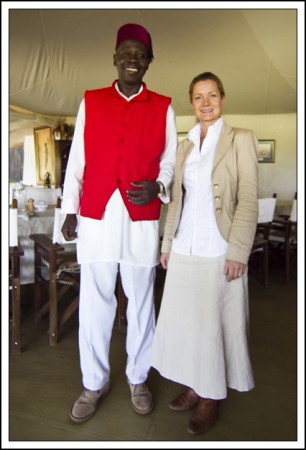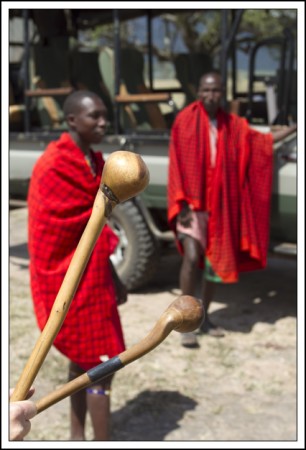After breakfast I went back to my tent and packed. Calvin and his crew had left the day before and the other guests, a young family from Italy I think it was, had departed before sunrise because they were taking a domestic flight from the Keekorok airstrip, about a two hour drive away. We were flying out on the Caravan from Calvin’s private airstrip, about a 20 minute drive from camp.
The camp seemed almost deserted. Next to the mess tent was a little round building, like the huts the Masai live in, with several elephant skulls in front. A handmade sign said Dapper Flappers 1920s Shop. In the whole time we’ve been here, I’ve never seen it open but I found Heidi, the camp manager, in her office next door and asked her if they had any maps in the shop and she said they did and got on the 2-way radio to ask someone to bring her the key.
There wasn’t a lot in the shop. Toiletries, medications for upset stomachs, a few books, and some Masai trinkets: carved wooden elephants, beaded bracelets, woven baskets—the typical sort of curios you could get at the Masai Market in Nairobi for a fraction of the cost. I was looking for a map of the Masai Mara but all they had was one of Kenya. Heidi said she’d been trying to find a good Masai Mara map but there just weren’t any. So I bought the Kenya map which was $26. It was far and away the most expensive map I’ve ever bought in my life. When I unfolded it inside the mess tent, I saw that in addition to a beautifully rendered map of Kenya that included wonderful illustrations of a Masai moran, or warrior, cheetah, elephant, and a baobab tree, among others, the flip side also had very detailed maps of not only the Masai Mara but also Laikipia, The Great Rift Valley, and Nairobi. I don’t know that it was worth $26 but it was a very nice map.
I have been remiss in not mentioning Heidi before now. She and her husband Josh run the camp in Calvin’s absence. They are both in their twenties and both extremely capable and attractive people. Heidi handles everything from organizing the Masai guides for game-watching to hosting dinners with the clients each night (which, as you can imagine, could get extremely tiresome when you don’t have guests like Uma Thurman and Ed Norton, as they have had). Josh, it seems, does everything Heidi doesn’t—organize the many game-watching vehicles, repair equipment, build new tents and other structures, and also run guests to the airstrips. In fact, Josh was taking us this morning to meet our plane.
Heidi, dressed as if she were an extra in the movie Out of Africa, came with William, looking dapper as usual in his crimson vest and red fez, to say good-bye, and then Josh organized our luggage and we were off to the airstrip. The morning was beautiful and we passed any number of dik-diks and gazelles, wildebeest and zebra, and even a few giraffes on the short drive. When I saw the Caravan, guarded by two Masai crouched beneath the shadow of its wing, I felt a mixture of excitement and sadness. We were headed up towards Mt. Kenya and into Samburu country and it is always exciting to be heading into new country in Africa or anywhere else for that matter, but we were also leaving this special little corner of the Mara behind and I would miss William bringing me a gin and tonic in the late afternoon and the cry of the raptors floating in the thermals over the camp and the heady smell of leleshwa when walking in the bush.
While Hamish checked over the plane the rest of us loaded our luggage, except for Pete who, while taking photos of the Masai, decided he quite liked one of the simple but nasty looking weapons they all carry, called a rungu, which is nothing more than a carved hard wood club about two feet long with a knob on the end. The rungu is used for hunting and for protection, both from animal predators and human ones as well (in fact, former Kenyan president Daniel Moi liked to be seen with his elegant silver-tipped rungu which he would sometimes pound on a table or his desk when he was angry as a form of intimidation, much like Nikita Krushchev’s famous shoe-pounding episode with Richard Nixon I suppose).
The Masai wanted something like 400 Kenyan shillings for his rungu, which is like $5, but none of us had anything smaller than a thousand note so he ended up buying both of them. And then letting them keep the extra 200 shillings since the one thing the Masai do not carry around with them is a wallet or change. Pete didn’t mind. He was quite happy with his marungu (the plural of rungu) since they were truly authentic if not as elaborately decorated as those sold in tourist shops in Nairobi.
And then we shook Josh’s hand and climbed into the Caravan, me sitting in the co-pilot seat in front and Pete in the very back so he could lower a window and hang out the plane and take photos as we flew over Masai Mara, and Hardy and Fletch in the middle. Hamish guided the plane over the bumpy airstrip, turned the nose into the wind, and we lifted off, Josh waving goodye and the Masai morani watching stoically as we cleared the far hills and disappeared over the horizon.
Tags: Masai Mara



Recent Comments